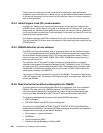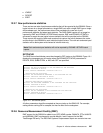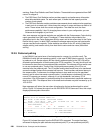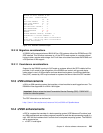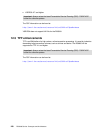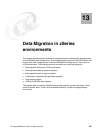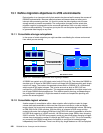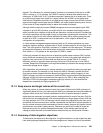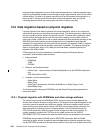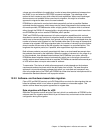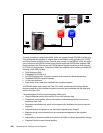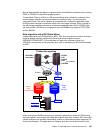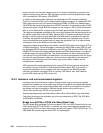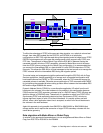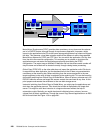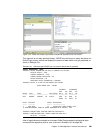
254 DS6000 Series: Concepts and Architecture
source storage subsystems to one or fewer target storage servers. A second migration layer
might be to consolidate multiple source volumes to larger target volumes, which is also called
volume folding. The latter is in general more difficult to do and requires data migration on a
data set level. It usually needs a few but brief service interruptions, when moving the
remaining data sets which are usually open and active 24 hours every day.
13.2 Data migration based on physical migration
Physical migration here refers to physical full volume operations, which in turn require the
same device geometry on the source and target volume. The device geometry is defined by
the track capacity and the number of tracks per cylinder. The same device geometry means
that the source and target device have the same track capacity and the same number of
tracks per cylinder. Usually this is not an issue because over time the device geometry of the
IBM 3390 volume has become a quasi standard and most installations have used this
standard. For organizations still using other device geometry (for example, 3380), it might be
worthwhile to consider a device geometry conversion, if possible. This requires moving the
data on a logical level, which is on a data set level and allows a reblocking during the
migration from 3380 to 3390.
Utilizing physical full volume operations is possible through the following software-,
microcode-, and hardware-based functions:
Software-based
–DFSMSdss
–TDMF
– FDRPAS
Software- and hardware-based:
– zSeries Piper - uses currently a zSeries Multiprise® server with ESCON attachment
only
– z/OS Global Mirror (XRC)
Hardware- and microcode-based:
– Global Mirror
– Global Copy
– FlashCopy in combination with either Global Mirror or Global Copy, or both
– Metro/Global Copy
The following section discusses DFSMSdss and the Remote Copy-based approaches in
some more detail.
13.2.1 Physical migration with DFSMSdss and other storage software
Full volume copy through the DFSMSdss COPY command copies all data between like
devices from a source volume to a target volume. The target volume might be bigger than the
source but cannot be smaller than the source volume. You have to keep the same volume
name and the same volume serial number (VOLSER) on the target volume; otherwise, the
data set cannot be located any more via catalog locates. This is achieved through the
COPYVOLID parameter. When the target volume is larger than the source volume, it is
usually necessary to adjust the VTOC size on the target volume with the ICKDSF
REFORMAT REFVTOC command to make the entire volume size accessible to the system.
DFSMSdss also provides full DUMP and full RESTORE commands. With the DUMP
command an entire volume is copied to tape cartridges and can then be restored from tape
via the RESTORE command to the new source volume. During that time all data sets on that



